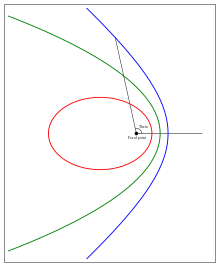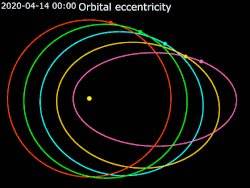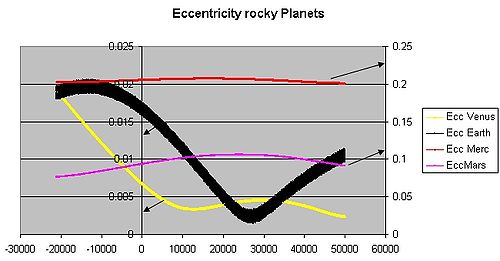Orbital eccentricity

Elliptic (eccentricity = 0.7)
Parabolic (eccentricity = 1)
Hyperbolic orbit (eccentricity = 1.3)

0.0 · 0.2 · 0.4 · 0.6 · 0.8
| Part of a series on |
| Astrodynamics |
|---|
In
Definition
In a
The eccentricity may take the following values:
- Circular orbit: e = 0
- Elliptic orbit: 0 < e < 1
- Parabolic trajectory: e = 1
- Hyperbolic trajectory: e > 1
The eccentricity e is given by[1]
where E is the total
, and the coefficient of the inverse-square law central force such as in the theory of gravity or electrostatics in classical physics:or in the case of a gravitational force:[2]: 24
where ε is the
For values of e from 0 to 1 the orbit's shape is an increasingly elongated (or flatter) ellipse; for values of e from 1 to infinity the orbit is a hyperbola branch making a total turn of 2 arccsc(e), decreasing from 180 to 0 degrees. Here, the total turn is analogous to turning number, but for open curves (an angle covered by velocity vector). The limit case between an ellipse and a hyperbola, when e equals 1, is parabola.
Radial trajectories are classified as elliptic, parabolic, or hyperbolic based on the energy of the orbit, not the eccentricity. Radial orbits have zero angular momentum and hence eccentricity equal to one. Keeping the energy constant and reducing the angular momentum, elliptic, parabolic, and hyperbolic orbits each tend to the corresponding type of radial trajectory while e tends to 1 (or in the parabolic case, remains 1).
For a repulsive force only the hyperbolic trajectory, including the radial version, is applicable.
For elliptical orbits, a simple proof shows that yields the projection angle of a perfect circle to an ellipse of eccentricity e. For example, to view the eccentricity of the planet Mercury (e = 0.2056), one must simply calculate the inverse sine to find the projection angle of 11.86 degrees. Then, tilting any circular object by that angle, the apparent ellipse of that object projected to the viewer's eye will be of the same eccentricity.
Etymology
The word "eccentricity" comes from
Calculation
The eccentricity of an orbit can be calculated from the orbital state vectors as the magnitude of the eccentricity vector:
- e is the eccentricity vector ("Hamilton's vector").[2]: 25, 62–63
For
- ra is the radius at apoapsis (also "apofocus", "aphelion", "apogee"), i.e., the farthest distance of the orbit to the center of mass of the system, which is a focusof the ellipse.
- rp is the radius at periapsis(or "perifocus" etc.), the closest distance.
The eccentricity of an elliptical orbit can also be used to obtain the ratio of the
For Earth, orbital eccentricity e ≈ 0.01671,
For Earth's annual orbit path, the ratio of longest radius (ra) / shortest radius (rp) is
Examples

| Object | eccentricity |
|---|---|
| Triton | 0.00002 |
| Venus | 0.0068 |
| Neptune | 0.0086 |
| Earth | 0.0167 |
| Titan | 0.0288 |
| Uranus | 0.0472 |
| Jupiter | 0.0484 |
| Saturn | 0.0541 |
| Moon | 0.0549 |
1 Ceres |
0.0758 |
| 4 Vesta | 0.0887 |
| Mars | 0.0934 |
| 10 Hygiea | 0.1146 |
| Makemake | 0.1559 |
| Haumea | 0.1887 |
| Mercury | 0.2056 |
| 2 Pallas | 0.2313 |
| Pluto | 0.2488 |
| 3 Juno | 0.2555 |
| 324 Bamberga | 0.3400 |
| Eris | 0.4407 |
| Nereid | 0.7507 |
| Sedna | 0.8549 |
| Halley's Comet | 0.9671 |
Comet Hale-Bopp |
0.9951 |
Comet Ikeya-Seki |
0.9999 |
| C/1980 E1 | 1.057 |
| ʻOumuamua | 1.20[a] |
| 2I/Borisov | 3.5[b] |
The eccentricity of Earth's orbit is currently about 0.0167; its orbit is nearly circular. Venus and Neptune have even lower eccentricities. Over hundreds of thousands of years, the eccentricity of the Earth's orbit varies from nearly 0.0034 to almost 0.058 as a result of gravitational attractions among the planets.[3]
The table lists the values for all planets and dwarf planets, and selected asteroids, comets, and moons.
Most of the Solar System's asteroids have orbital eccentricities between 0 and 0.35 with an average value of 0.17.[4] Their comparatively high eccentricities are probably due to the influence of Jupiter and to past collisions.
The
ʻOumuamua is the first interstellar object found passing through the Solar System. Its orbital eccentricity of 1.20 indicates that ʻOumuamua has never been gravitationally bound to the Sun. It was discovered 0.2 AU (30000000 km; 19000000 mi) from Earth and is roughly 200 meters in diameter. It has an interstellar speed (velocity at infinity) of 26.33 km/s (58900 mph).
Mean average
The mean eccentricity of an object is the average eccentricity as a result of perturbations over a given time period. Neptune currently has an instant (current epoch) eccentricity of 0.0113,[11] but from 1800 to 2050 has a mean eccentricity of 0.00859.[12]
Climatic effect
Orbital mechanics require that the duration of the seasons be proportional to the area of Earth's orbit swept between the
Apsidal precession also slowly changes the place in Earth's orbit where the solstices and equinoxes occur. This is a slow change in the orbit of Earth, not the axis of rotation, which is referred to as axial precession. The climatic effects of this change are part of the Milankovitch cycles. Over the next 10000 years, the northern hemisphere winters will become gradually longer and summers will become shorter. Any cooling effect in one hemisphere is balanced by warming in the other, and any overall change will be counteracted by the fact that the eccentricity of Earth's orbit will be almost halved.[15] This will reduce the mean orbital radius and raise temperatures in both hemispheres closer to the mid-interglacial peak.
Exoplanets
Of the many
See also
Footnotes
References
- OCLC 191847156.
- ^ ISBN 978-0-486-49704-4. Retrieved 4 March 2022.
- ^ A. Berger & M.F. Loutre (1991). "Graph of the eccentricity of the Earth's orbit". Illinois State Museum (Insolation values for the climate of the last 10 million years). Archived from the original on 6 January 2018.
- ^ Asteroids Archived 4 March 2007 at the Wayback Machine
- ^ David R. Williams (22 January 2008). "Neptunian Satellite Fact Sheet". NASA.
- ^
Lewis, John (2 December 2012). Physics and Chemistry of the Solar System. Academic Press. ISBN 9780323145848.
- ^ a b "JPL Small-Body Database Browser: C/1995 O1 (Hale-Bopp)" (2007-10-22 last obs). Retrieved 5 December 2008.
- ^ a b "JPL Small-Body Database Browser: C/2006 P1 (McNaught)" (2007-07-11 last obs). Retrieved 17 December 2009.
- ^ "Comet C/2006 P1 (McNaught) – facts and figures". Perth Observatory in Australia. 22 January 2007. Archived from the original on 18 February 2011.
- ^ "JPL Small-Body Database Browser: C/1980 E1 (Bowell)" (1986-12-02 last obs). Retrieved 22 March 2010.
- ^ Williams, David R. (29 November 2007). "Neptune Fact Sheet". NASA.
- ^ "Keplerian elements for 1800 A.D. to 2050 A.D." JPL Solar System Dynamics. Retrieved 17 December 2009.
- ^ Data from United States Naval Observatory Archived 13 October 2007 at the Wayback Machine
- .
- ^ "Long Term Climate". ircamera.as.arizona.edu. Archived from the original on 2 June 2015. Retrieved 1 September 2016.
- ^ "ECCENTRICITY". exoplanets.org.
- ISBN 0-387-98701-0.
- PMID 25512527.
- )
- ^ Zubritsky, Elizabeth. "Jupiter's Youthful Travels Redefined Solar System". NASA. Archived from the original on 9 June 2011. Retrieved 4 November 2015.
- ^ Sanders, Ray (23 August 2011). "How Did Jupiter Shape Our Solar System?". Universe Today. Retrieved 4 November 2015.
- ^ Choi, Charles Q. (23 March 2015). "Jupiter's 'Smashing' Migration May Explain Our Oddball Solar System". Space.com. Retrieved 4 November 2015.
- ^ Davidsson, Dr. Björn J. R. (9 March 2014). "Mysteries of the asteroid belt". The History of the Solar System. Retrieved 7 November 2015.
- ^ Raymond, Sean (2 August 2013). "The Grand Tack". PlanetPlanet. Retrieved 7 November 2015.
- S2CID 51737711.
- S2CID 118489638.
- ^ "Is Earthly Life Premature from a Cosmic Perspective?". Harvard-Smithsonian Center for Astrophysics. 1 August 2016.
Further reading
- Prussing, John E.; Conway, Bruce A. (1993). Orbital Mechanics. New York: Oxford University Press. ISBN 0-19-507834-9.
External links
- World of Physics: Eccentricity
- The NOAA page on Climate Forcing Data includes (calculated) data from Berger (1978), Berger and Loutre (1991)[permanent dead link]. Laskar et al. (2004) on Earth orbital variations, Includes eccentricity over the last 50 million years and for the coming 20 million years.
- The orbital simulations by Varadi, Ghil and Runnegar (2003) provides series for Earth orbital eccentricity and orbital inclination.
- Kepler's Second law's simulation











